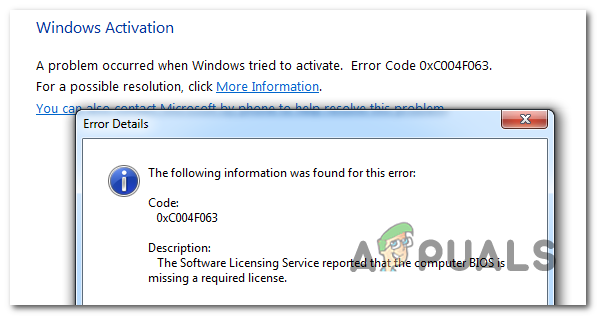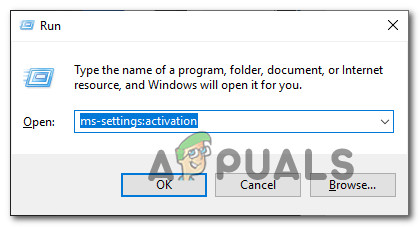How to Fix Windows Activation Error 0xc004f063?
Several Windows users have been reaching us with questions after being unable to activate their Windows build. The error code that comes up after this process fails is 0xc004f063. In most cases, the error code is accompanied by the error message “The Sofware Licensing Service reported that the computer BIOS is missing a required license.” The issue is much more common on Windows 7, but we also managed to find some occurrences in Windows 8.1 and Windows 10.

What’s causing the Windows Activation Error 0xc004f063?
We investigated this particular issue by looking at various user reports and by testing out the various repair strategies that some affected users have successfully used to resolve this error code and activate their Windows version successfully.
As it turns out, several causes might lead to the apparition of the Windows Activation Error 0xc004f063. Here’s a shortlist of potential culprits:
- Licensing restriction – As it turns out, a Windows 10 glitch might end up facilitating the apparition of a licensing restriction in instances when it’s not applicable. If this scenario is applicable, you can resolve the issue by running the Windows Activation troubleshooter.
- BIOS inconsistency – A fairly common scenario that will spawn this error code is a situation where the user has brought a pre-activated computer and then reset it. In this case, trying to activate a different license (like PRO over Home) will spawn this error because the old key is still stored on your BIOS settings. In this case, you can override the settings by using the SLMGR utility.
- System File Corruption – According to several affected users, system file corruption can also facilitate the apparition of this issue. A critical activation process may be affected by system file corruption so the activation is not validated. In this case, you should be able to resolve the issue by running a couple of utilities (DISM and SFC) capable of instances of system corruption.
- License key inconsistency – It’s also possible that the issue is entirely beyond your control. As some users have reported, you could see this issue due to a problem with ho MS servers view your license key. If this scenario, the only way that you can resolve the issue is to contact a Microsoft agent and ask them to activate the key remotely.
If you’re currently struggling with the same issue and one of the potential scenarios presented above seem like they could be applicable, chances are this article will allow you to solve your problem. Down below, you’ll find a collection of potential fixes that other users in a similar situation have successfully used to resolve the problem.
If you want to remain as efficient a possible, we advise you to follow the methods below in the same order as we arranged them in (via difficulty and efficiency). Eventually, you will stumble upon a fix that should resolve the issue regardless of the culprit that’s causing the problem.
Let’s begin!
Method 1: Running the activation troubleshooter (Windows 10 Only)
Before you pursue other repair strategies, let’s see if your Windows version is not equipped to resolve the issue automatically. Keep in mind that Windows 10 includes several different automated repair strategies that the system is capable of enforcing in case a familiar scenario is discovered.
If the issue is being caused by some kind of licensing restriction, The Windows Activation troubleshooter should be able to correct in automatically. This built-in tool contains a selection of repair strategies that will automatically resolve the issue if your activation problem is already covered by a repair strategy.
IMPORTANT: This method is only applicable if you’re encountering the issue on Windows 10. If you’re encountering the 0xc004f063 error with an older Windows version, move down to the next method below.
Several affected users have confirmed that they managed to resolve the 0xc004f063 Activation Error by running the Activation utility and restarting their computer. At the next startup, they tried to activate the license key again and the procedure was successful.
Here’s a quick guide on how to use the Activation troubleshooter:
- Press Windows key + R to open up a Run dialog box. Next, type ”ms-settings:activation’ and press Enter to open up the Activation tab of the Settings screen.

Accessing the Activation troubleshooter - Once you’re inside the Activation tab, turn your attention towards the right pane and look for the Activate section (at the bottom of the screen). Once you’re there, click the Troubleshoot button.

Accessing the Activation Troubleshooter - Wait until the utility is launched, then wait patiently until it inspects your system for any inconsistencies. If any fixable problems are discovered, you will be presented with a repair strategy. To enforce it, click on Apply this fix and wait for the operation to complete.

Apply this fix - Once the fix has been applied, restart your computer and wait for the next startup sequence to complete. After the next startup, move down to the next method below.
Method 2: Activating your Windows using SLMGR
If you’re seeing the 0xc004f063 error when trying to activate a PRO key (immediately after you submit it), chances are the problem is caused by the fact that your BIOS is still using the Windows Home key. This is quite common in instances where the user previously brought a pre-activated computer and then reset it.
In case this scenario is applicable, your OS will try to activate your OS with the key stored on your BIOS, regardless of the activation key that you’re trying to force. If you find yourself in a similar situation, you can override the wrong activation key by a series of commands inputted inside an elevated Command Prompt. Here’s what you need to do:
- Press Windows key + R to open up a Run dialog box. Once you’re inside the Run box, type “cmd” inside the text box and press Ctrl + Shift + Enter to open up a Run dialog box. When you’re prompted by the UAC (User Account Control) click Yes to grant administrative privileges.

Opening the Command Prompt - When you’re inside the elevated Command Prompt, type the following commands (press Enter after each one) to change the used license key to the correct one:
slmgr /ipk <Windows Key> slmgr /ato
Note: Keep in mind that *Windows key* is simply a placeholder. You’ll need to replace it with your license key to complete this process successfully.
- If the procedure is completed successfully, restart your computer and see if the change becomes active at the next computer startup.
If your Windows build is still not activating despite having a valid license key, move down to the next method below.
Method 3: Running SFC and DISM scans
As it turns out, one of the most common causes that might facilitate the apparition of the Windows Activation Error 0xc004f063 is some type of system file corruption. In most cases, this problem occurs because a critical activation process is actually affected, so your OS is unable to validate this procedure.
If this scenario is applicable in your case, the most efficient way of resolving the issue is to run a series of built-in utilities capable of fixing local errors and corruption among the operating system files. Keep in mind that both DISM (Deployment Image Servicing and Management) and SFC (System File Checker) is ultimately capable of doing this, but they do it in different ways.
DISM relies heavily on WU (Windows Update) to replace corrupted items with healthy copies, while SFC relies on a locally stored archive to deal with system file corruption. SFC is better at fixing logical errors while DISM is superior when it comes to finding corrupted sub-processes.
To maximize your chances of resolving this issue, we encourage you to run both utilities to maximize your chances of fixing every corrupted instance that might end up causing the 0xc004f063 error. Here’s are some step by step instructions with what you need to do:
- Press Windows key + R to open up a Run dialog box. Next, type ‘cmd’ inside the text box and press Ctrl + Shift + Enter to open up a Command Prompt with admin access.

Opening the Command Prompt Note: If you see the UAC (User Account Control) prompt, click Yes to grant admin access.
- Once you’re inside the elevated CMD window, type the following command in order and press Enter to initiate a DISM command:
Dism.exe /online /cleanup-image /scanhealth Dism.exe /online /cleanup-image /restorehealth
Note: Before you initiate this procedure, ensure that your Internet connection is stable. This is important because DISM uses WU to download healthy files that will be used to replace corrupted items. Just so you know what the commands do, the first (scanhealth) will analyze your system for any inconsistencies while the second (restorehealth) will start the repair procedure.
- Wait until the process is complete, then restart your computer and wait patiently until the next startup procedure is complete. After this, follow step 1 once again to open up another elevated CMD prompt. But this time, type the following command and press Enter to initiate an SFC scan:
sfc /scannow
Note: Regardless of the circumstances, do not interrupt this procedure before it completes (even if you see it freezing for a couple of minutes). Doing this puts your system at risk and you might end up with other logical errors that might create additional logical errors.
- Once the second system file scan is finished, restart your computer and see if the issue is resolved at the next system startup.
If you’ve followed the instructions above and you’re still encountering the 0xc004f063 error, move down to the next method below.
Method 4: Contacting Microsoft’s support
If none of the methods above didn’t allow you to activate your Windows build and you’re still encountering the 0xc004f063 error, the best course of action is to get in contact with Microsoft’s support team and ask them to activate your operating system.
There are a couple of different ways that will allow you to do this, but the most convenable way of getting this sorted is to get in touch with a Microsoft Agent via the toll-free number that’s specific to the region where you are located.
Here’s a list (here) with country-specific phone numbers. Keep in mind that depending on your region and the number of support agents that are active in that time-frame, you might need to wait a couple of hours before you get in contact with a live agent.
Once you manage to speak to a human, you will be asked several security questions to confirm that you own the license key that you’re trying to activate. If everything checks out, they will activate your Windows build remotely.




